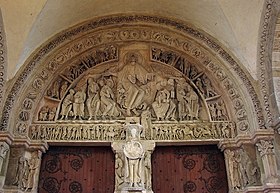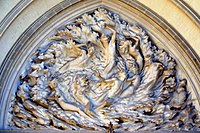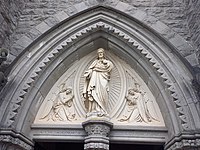Tympanum (architecture)

A tympanum (pl.: tympana; from Greek and Latin words meaning "drum") is the semi-circular or triangular decorative wall surface over an entrance, door or window, which is bounded by a lintel and an arch. It often contains pedimental sculpture or other imagery or ornaments. Many architectural styles include this element.
Alternatively, the tympanum may hold an inscription, or in modern times, a clock face.
History
In ancient Greek, Roman and Christian architecture, tympana of religious buildings often contain pedimental sculpture or mosaics with religious imagery. A tympanum over a doorway is very often the most important, or only, location for monumental sculpture on the outside of a building. In classical architecture, and in classicising styles from the Renaissance onwards, major examples are usually triangular; in Romanesque architecture, tympana more often has a semi-circular shape, or that of a thinner slice from the top of a circle, and in Gothic architecture they have a more vertical shape, coming to a point at the top. These shapes naturally influence the typical compositions of any sculpture within the tympanum.
The upper portion of a gable when enclosed with a horizontal belt course, is also termed a tympanum.
Bands of molding surrounding the tympanum are referred to as the archivolt.
In medieval French architecture the tympanum is often supported by a decorated pillar called a trumeau.
Gallery
-
![Baroque tympanum in the Queen's Bedroom in the Louvre Palace, Paris, by Michel Anguier and Pietro Sasso, with a painting of Judith and Holophernes, by Giovanni Francesco Romanelli, 1655[7]](//upload.wikimedia.org/wikipedia/commons/thumb/2/26/Ceilings_of_the_appartements_d%27%C3%A9t%C3%A9_de_la_reine_Anne_d%27Autriche_%28449%29_%28tympanum_cropped%29.jpg/200px-Ceilings_of_the_appartements_d%27%C3%A9t%C3%A9_de_la_reine_Anne_d%27Autriche_%28449%29_%28tympanum_cropped%29.jpg) Baroque tympanum in the Queen's Bedroom in the Louvre Palace, Paris, by Michel Anguier and Pietro Sasso, with a painting of Judith and Holophernes, by Giovanni Francesco Romanelli, 1655
Baroque tympanum in the Queen's Bedroom in the Louvre Palace, Paris, by Michel Anguier and Pietro Sasso, with a painting of Judith and Holophernes, by Giovanni Francesco Romanelli, 1655 -
 Ex Nihilo (Out of Nothing) by Frederick Hart, tympanum over center doors, Washington National Cathedral, US
Ex Nihilo (Out of Nothing) by Frederick Hart, tympanum over center doors, Washington National Cathedral, US -
 Tympanum of Kumari-ghar at Basantapur Durbar Square, Kathmandu
Tympanum of Kumari-ghar at Basantapur Durbar Square, Kathmandu -
-
 The three tympana on the main façade of Notre-Dame de Paris, France
The three tympana on the main façade of Notre-Dame de Paris, France -
Sculpted tympanum in Stralsund, Germany
-
 Adoration of the Magi on a tympanum on Saint-Thiébaut Church, Thann, France
Adoration of the Magi on a tympanum on Saint-Thiébaut Church, Thann, France -
 Religious scene in a tympanum, Church San Lorenzo, Vicenza, Italy
Religious scene in a tympanum, Church San Lorenzo, Vicenza, Italy -
Scenes of the lives of Saint Peter and Mary, St Peter's, Vitoria-Gasteiz, Spain
-
 High-relief bronze tympanum of Writing, Thomas Jefferson Building, Washington, D.C., US
High-relief bronze tympanum of Writing, Thomas Jefferson Building, Washington, D.C., US -
 Tympanum (showing the tree of life) and archivolt at Church of St Mary and St David, Kilpeck, Herefordshire, England
Tympanum (showing the tree of life) and archivolt at Church of St Mary and St David, Kilpeck, Herefordshire, England -
 Tympanum showing Christ in Majesty with four attendant angels, Rowlestone, Herefordshire, England
Tympanum showing Christ in Majesty with four attendant angels, Rowlestone, Herefordshire, England -
 Tympanum of the Manila Cathedral in Intramuros, Philippines
Tympanum of the Manila Cathedral in Intramuros, Philippines -
 Tympanum of the church of the Sacred Heart, Templemore, Ireland
Tympanum of the church of the Sacred Heart, Templemore, Ireland
See also
- Lunette: semi-circular tympanum
- Church architecture
- Gable
- Pediment
- Portal
![Baroque tympanum in the Queen's Bedroom in the Louvre Palace, Paris, by Michel Anguier and Pietro Sasso, with a painting of Judith and Holophernes, by Giovanni Francesco Romanelli, 1655[7]](http://upload.wikimedia.org/wikipedia/commons/thumb/2/26/Ceilings_of_the_appartements_d%27%C3%A9t%C3%A9_de_la_reine_Anne_d%27Autriche_%28449%29_%28tympanum_cropped%29.jpg/200px-Ceilings_of_the_appartements_d%27%C3%A9t%C3%A9_de_la_reine_Anne_d%27Autriche_%28449%29_%28tympanum_cropped%29.jpg)












